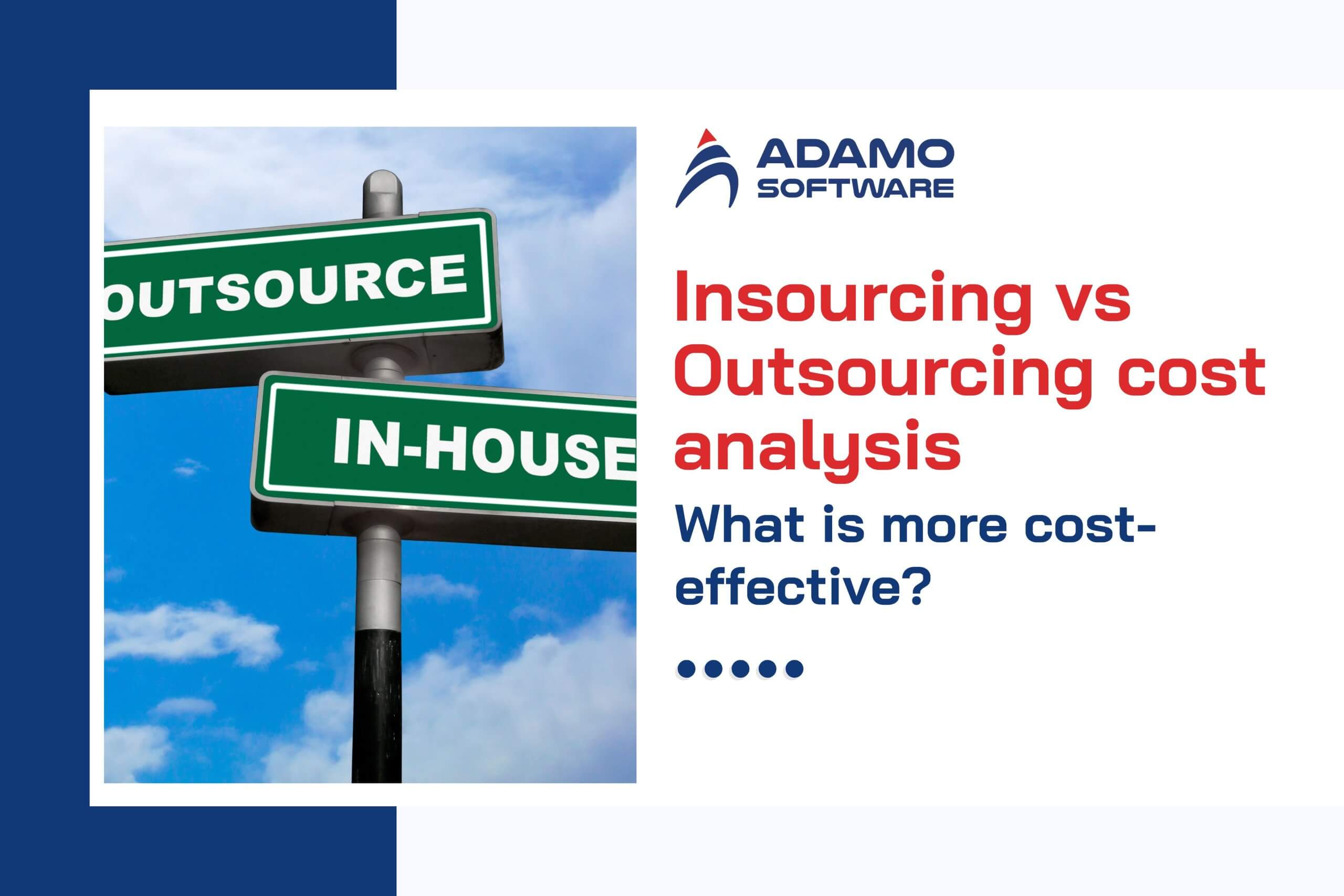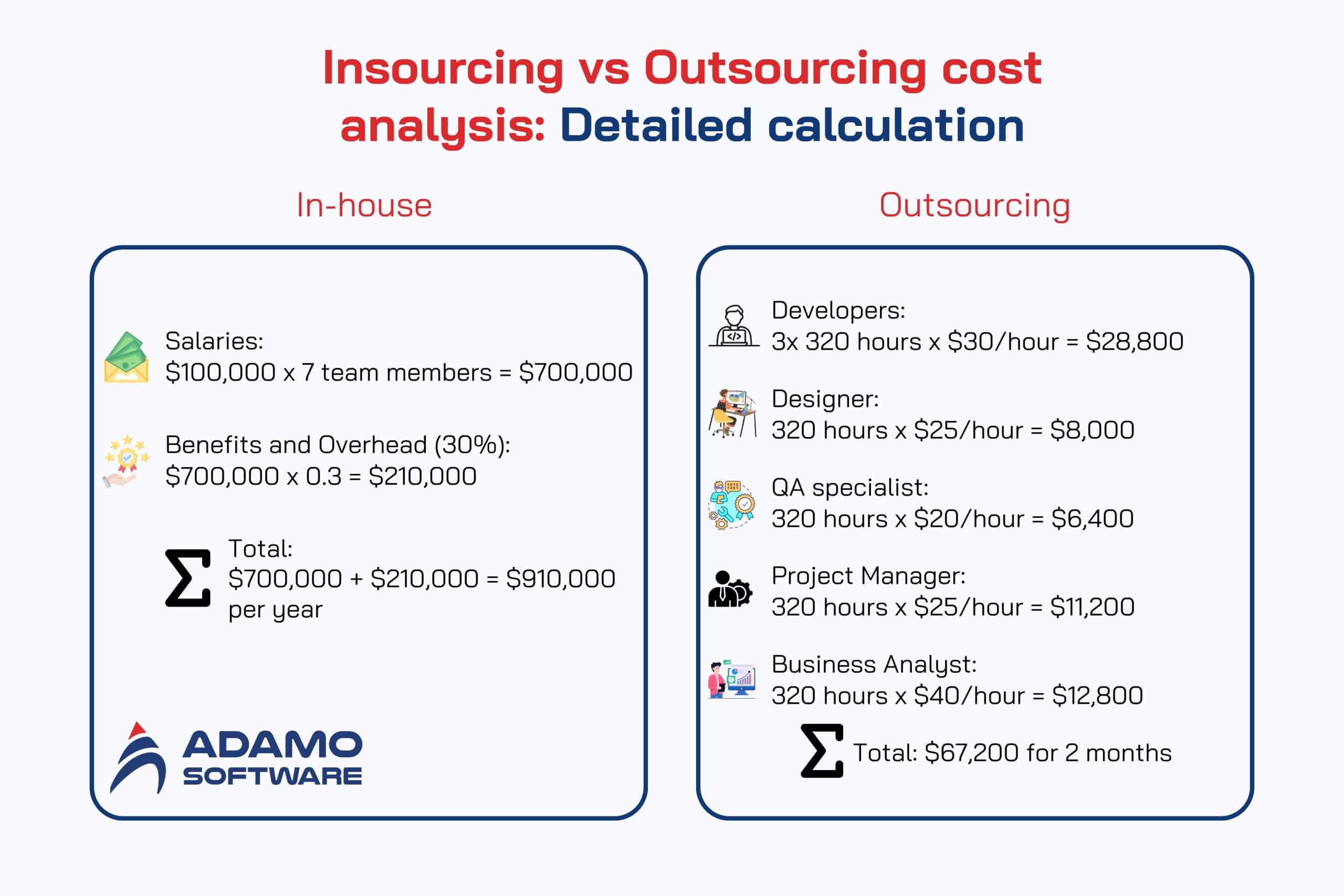Insourcing vs Outsourcing cost analysis: What is more cost-effective?

The decision of whether to insource or to outsource has become a big challenge for most businesses. This decision concerns costs and work efficiency, becoming directly relevant to the company’s operations. To do this, one must conduct an insourcing vs outsourcing cost analysis to make the right decision.
Each approach has its advantages and disadvantages, especially in terms of costs. Insourcing gives complete control to the companies, though it may need more initial investment. Outsourcing, in contrast, can make operations cheaper while at the same time surrendering direct control over the processes.
Therefore, this article explores the insourcing vs outsourcing cost analysis to reveal which is more cost-effective. Depending on the industry, budget, and objectives, 1the choice can differ. Normally, most companies do not factor in the additional expenses linked to each approach. This guide will provide all the facts and information to help you make the right decision.
At the end of this blog, you’ll see how the insourcing vs outsourcing cost analysis can change your business. Regardless of your company size, start-up or established, this guide will be useful for you. Now, let’s look at the numbers and find out which solution will be more effective for your business!
I. Factors affect Insourcing vs Outsourcing cost analysis
Essentially, insourcing versus outsourcing costs depend on your needs and strategic plan. Outsourcing is generally cost-effective and much more flexible when short-term projects or specific work is needed. It makes it possible for businesses to make changes often without incurring heavy long-term costs.
On the other hand, when it comes to fundamental processes that need to be tightly connected to your company’s values, you might get a significantly better result by building your team. This approach ensures that these processes remain stable for the long term. Generally, an in-house team can better match your company’s goals and values.
Now, let’s break down the cost difference between sourcing and outsourcing.
1. In-house costs
Recruitment & onboarding
Recruiting and onboarding new employees can be time-consuming and expensive. It is a scheduled process of hiring, which involves job posting, interviews, background checks, and training. Each of these adds to the overall cost of bringing new talent to your organization. It’s crucial that this investment ensures new hires fit well within the company culture.
Salaries & benefits
In an insourcing vs outsourcing cost analysis, ongoing costs for employee compensation are substantial. It’s also about expenses like salaries, health benefits, retirement plans, and other perks. These costs are fixed and must be paid, even if the company profits or performs poorly. Hence, they constitute a key element of the in-house cost structure.
Infrastructure
Maintaining a physical workspace involves various costs, such as office space, equipment, software, and tools. This includes rent, utilities, and regular maintenance expenses. Infrastructural costs can pile up quickly, and you need to consider them when deciding whether your organization should insource or outsource.
Retention
Retention efforts are related to keeping employees engaged and reducing turnover rates. All these include professional development programs, team-building activities, and competitive packages. Your employees are your greatest asset, so investing in making them happy can pay off in higher productivity and lower turnover costs.
2. Outsourcing costs
Service fees
Service fees paid to third-party providers are key to outsourcing costs. The payments for these projects are usually based on the project’s scope or duration. The fees in outsourcing vary a lot depending on how complicated and long the project is to be outsourced.
Communication
The insourcing vs outsourcing cost analysis is impossible without effective team members’ communication. Communication-related potential costs include investment in tools and technologies to enable in-house and outsourced teams to collaborate. Having clear communication helps bridge any gaps due to being with external partners.
Quality control
Monitoring and assuring the quality of outsourced work expenses are critical for quality control expenses. Maintaining high standards requires regular audits, performance reviews, and quality-assured processes. That is to say, these activities make sure that the output matches your company’s expectations.
Transition
The costs of the initial work transition to an outsourcing partner should not be overlooked. These could be knowledge transfer, process documentation, and initial onboarding of the outsourced team. A successful collaboration with external partners depends on properly managing this transition.
A complete insourcing vs outsourcing cost analysis is useful to businesses in determining the best practice to adopt in deciding operational strategies. Understanding in-house and outsourcing costs is important to optimize resources effectively.
II. Insourcing vs Outsourcing cost analysis: Detailed calculation
Many businesses need to decide whether to outsource IT services, which is a challenge. Comparing these costs is important before you decide whether to choose in-house or outsourced development. This insourcing vs outsourcing cost analysis can give you insights into your strategy.

1. Costs of In-house product development
Building an in-house development team takes a few steps and a few bucks. An in-house team usually consists of a front-end developer, back-end developer, UI/UX designer, QA/QC specialist, business analyst, architect, and project manager.
Maintaining such a team is expensive. Let’s say the average salary for each U.S. team member is $100,000. In addition, salaries, benefits, and overhead costs (including health insurance, bonuses, office space, and equipment) total 30 percent of the total wages.
Thus, the salaries of a seven-member team are $700,000 in total annual costs. On that basis, another $210,000 is added for benefits and overhead at 30%. This would result in an in-house yearly development team cost of $910,000 for the year. By conducting an insourcing vs outsourcing cost analysis of this figure against outsourced alternatives, you can cut costs.
2. Costs of outsourcing product development
One of the best reasons for outsourcing development is that it cuts away the overhead costs and businesses only pay for the services they need to perform. An outsourcing company might be able to hire a team that includes three mid-level developers, a designer, and a quality assurance specialist. This team could also consist of a project manager and a business analyst.
Let’s consider the average global hourly rates for these roles. The rate starts here: developers $30, designers $25, QA specialists $20, project managers $35, and business analysts $40. The roles will be 320 hours each for a two-month project, 40 hours per week.
The outsourcing total cost calculation is as follows. If you have three developers, that’s $28,800, the designer is $8,000 and the QA specialist is $6,400. The project manager would cost you $11,200 and the business analyst would cost you $12,800 as well. And that’s about $67,200 for two months of outsourced work.
So, when you do an insourcing vs outsourcing cost analysis, you can clearly see the financial benefits of outsourcing.
3. Cost comparison between in-house and outsourced development
There are distinct differences to see when you do a direct insourcing vs outsourcing cost analysis. The annual cost of maintaining an in-house development team would be $910,000 per annum or $75,833 per month. However, if the outsourcing cost is divided into two months of work, the total cost is $67,200, or $33,600 per month. This results in substantial savings. Specifically, it will help businesses save approximately $42,233 per month if they decide to outsource instead of creating an in-house team. This totals savings of roughly $84,466 over two months.
In general, outsourcing your product development will save you a lot of money. It saves you from the extra costs of having in-house teams and working on the core business. It’s also cheap and flexible with access to a global talent pool.
If properly done, the insourcing vs outsourcing cost analysis will allow you to meet your deadlines whilst maintaining operational efficiency and at minimal cost. An insourcing vs outsourcing cost analysis for your business may be something you want to think about if you want to make the best decision.
Read more: Insourcing vs outsourcing: What are the key differences?
III. Other reasons why you should choose outsourcing service
Upcity 2022 research shows that small businesses are becoming more likely to outsource services, and many have set to do so in 2023. Although this is an area of growing interest, cost remains a key concern for small businesses considering outsourcing. An insourcing vs outsourcing cost analysis will tell you if outsourcing is the right choice for your organization.

1. The urgency of hiring
Today, in the fast-moving business environment, an urgent hiring need may be necessary because of a sudden employee departure or an increased project demand. In times like these, companies should pause important business processes to fill the gap in their staffing or find an alternative solution immediately.
An alternative that works is outsourcing. If businesses can pay a slightly higher fee—normally about 15–20 percent more—they can immediately get the qualified professional ready. That minimizes downtime and allows important tasks to continue uninterrupted.
Another option is using an HR agency, which will come with many fees that can strain budgets. However, through insourcing vs outsourcing cost analysis, most companies have realized that outsourcing is a faster and more affordable way to get staffed up quickly. This approach helps them get back to productivity and meet deadlines.
2. Addressing the misfit dilemma
The right candidate to hire is crucial but often is a gamble. Companies spend lots of money choosing candidates and find they’re missing certain skills or don’t work with the company culture.
This risk is mitigated by outsourcing to a service provider who can provide a substitution guarantee. If outsourced people don’t fit, businesses can replace them in a week or less and cause minimal project disruption.
On the other hand, insourcing involves long procedures for off-boarding and on-boarding that can take weeks or months. An insourcing vs outsourcing cost analysis shows how outsourcing provides agility. It also reduces the costs of mismatched hires, which helps keep teams effective and aligned with objectives.
3. Navigating crises and economic recessions
Workforce decisions come quickly under economic downturns and financial crises, such as layoffs at companies like Coinbase, Zoom, and Twitter.
Flexibility is provided by outsourcing. Ending an outsourcing arrangement is as easy as a phone call if you have to reduce staff due to financial constraints. It is very flexible, which allows businesses to change quickly without incurring the emotional and legal burden of firing in-house staff.
During turbulence, an insourcing vs outsourcing cost analysis may show how outsourcing simplifies workforce management while minimizing risk. This makes it a strategic choice for navigating a crisis.
4. Motivation and employee engagement
Sustaining productivity and maintaining high-quality output depends on employee motivation. But that requires constant attention from the management team.
Shifting this responsibility to external service providers allows internal leaders to focus on strategic initiatives instead of daily personnel management. Companies can conduct an insourcing vs outsourcing cost analysis to learn that outsourcing increases operational efficiency. Also, this allows their internal teams to focus on high-impact activities.
Many benefits are available to businesses of all sizes when they outsource. Outsourcing addresses urgent hiring needs quickly and mitigates the risks of employee misfits. It allows flexibility during economic downturns. Additionally, it frees up internal teams to focus on core strategies.
By carefully conducting an insourcing vs. outsourcing cost analysis, organizations can make educated decisions regarding insourcing and outsourcing. This will help increase efficiency, cut costs, and maintain their long-term success.
IV. Why you should choose outsourcing software development of Adamo

After this insourcing vs outsourcing cost analysis, are you ready to outsource a software development company for your next project?
Choosing Adamo Software for your software development needs will give you many benefits. Outsourcing your project to us enables you to cut the overhead of hiring and training in-house teams.
With Adamo, you have access to a diverse talent pool, meaning you always have the right expertise to work on your project. The efficient scale of the resources we provide through our development models enables you to expand as needed.
You can rely on Adamo to serve you and your business with a full commitment to quality and transparency. Work with us to maximize your software development investment!
FAQs
1. What are the potential risks of insourcing?
Several risks associated with insourcing businesses need to be considered carefully. The biggest cost is the high price of hiring extra staff and building the necessary infrastructure. These expenses can stretch finances, especially for smaller organizations.
A second challenge is the risk of a shortage of expertise dedicated to the field. In-house teams might not have the right specific skills to do some tasks, which can hurt project quality and innovation.
Another one is scalability. Insourcing can slow it down for businesses, and they can’t quickly adapt to changing market demands. That’s when an insourcing vs outsourcing cost analysis can be conducted. If the additional expense and resource constraints are more expensive than outsourcing options, it may be useful to consider outsourcing.
In the end, these risks can draw us less focused on the key operations of our company and lower the efficiency of the whole.
2. How does outsourcing influence a company’s internal workforce?
Outsourcing can make a huge positive change for a company’s internal workforce. Mobilizing employees to these more strategic initiatives is facilitated by delegating routine non-core activities to external providers.
This shift reduces internal teams’ workload so they can spare some time and resources. This allows employees to focus on what matters most to the company: long-term goals and objectives.
Moreover, outsourcing also reduces stress on the team when dealing with heavy workloads. Businesses can assess whether insourcing or outsourcing tasks increases employee engagement and productivity. This can spur innovation and improve organizational performance through an insourcing vs outsourcing cost analysis.
3. Is outsourcing a good option for small businesses?
Absolutely! Outsourcing is a wonderful means for small businesses and startups to make the most of their resources without spending much money. Small businesses can leverage outsourcing providers’ expertise to deliver high-quality services that would otherwise be expensive to implement in-house.
It provides a better way of managing operational costs and improving efficiency in all areas. Insourcing vs outsourcing cost analysis can demonstrate how outsourcing allows small businesses to spend their budgets more smartly, allowing resources for growth and development.
Ultimately, outsourcing allows small companies to concentrate on their core strategy business while remaining competitive in the current fast-paced market.
4. Can a business implement both insourcing and outsourcing strategies?
Businesses can implement a hybrid approach to insourcing and outsourcing, effectively taking advantage of both insourcing and outsourcing. This balanced strategy allows organizations to maintain control over the critical functions essential to their vital mission. At the same time, they can outsource noncrucial functions to external providers.
By doing an insourcing vs outsourcing cost analysis, companies will be able to know which tasks would suit the in-house team better, and vice versa. This eventually helps companies allocate their resources effectively to increase productivity and flexibility
Combining the hybrid approach allows businesses to adapt quickly to changing market conditions while keeping key functions in alignment with the business strategic ones. Having the best of both worlds with this approach will also get companies a harmonious balance between control, efficiency, and innovation.











